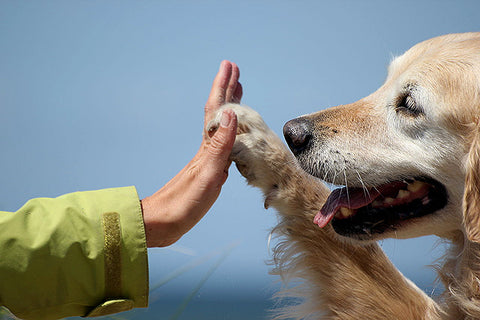Dog Training Classes 101

"You can't teach an old dog new tricks." We have all heard this old cliche, but there is actually no truth to it! Dogs can learn new behaviors at any time, it is up to us to teach them.
Some dogs compete in obedience courses, others take a few weeks to learn and respond consistently to 'sit'. Every dog learns differently and all of them are trainable. Some dogs respond to different techniques, but there is no breed or age that is 'better' at learning than others.
Some breeds have obedience in their blood, but all dogs are known for their intelligence and desire to please their owners. Training your dog, working on new tricks, and spending one-on-one time together creates a tighter bond between you and your dog!
Take a look at our selection of training treats you can use during this process!
Should my dog take a training class?

While puppies should absolutely attend training classes, the benefits are the same for dogs of any age. While young dogs (aged 8-12 weeks) make for fresh students, dogs can be trained out of bad behaviors with just a little bit of time and a lot of patience and love. If you have recently adopted an older dog, consider signing up for a basic training class. Having the trainer to help supervise and identify any behavioral issues early on will strengthen your bond and help your pup achieve great things!
**Some classes are restricted to puppies in order to allow them to socialize with other dogs of a similar size and temperament while under careful supervision. Most training facilities will offer separate "beginner" courses for older dogs.
There are classes for dogs at every level of obedience. Most classes require you sign up weeks to months ahead of time, so plan ahead (especially if you're bringing a puppy into your home) and sign up early. Many pet parents sign their dogs up for these kinds of classes only after they have started demonstrating bad behaviors. It is easier to train a dog to perform a positive behavior than to stop performing a negative one.
Training classes are not just for your pet, they help owners improve their skills as well! Classes teach you how to better communicate with your animal and guide you through the basics or advanced stages of how to train your dog.
What class is right for me?
While choosing a training school, there are a few important things to consider:
- Do they have proper credentials? Ask if they’re Certified Professional Dog Trainer-Knowledge Assessed (CPDT-KA). Some trainers choose to forgo this training but have years of experience. Ask questions and get to know them before signing up!
- How long have they been around? Do they have at least a couple of years of experience?
- Are they a good fit for you? Do you have good rapport with the staff? Are they professional?
- Can you sit in on a class without your pup? If so, notice what methods they use, whether they're calm or yelling, and whether the dogs and owners seem happy.

Living in such a pet-friendly city as Portland, there are so many great options to choose from when it comes to a school. Happy Go Lucky on NE 28th and Glisan is POB's recommendation for a local training facility. They offer classes for novice trainers through advanced. Their classes fill up fast, so sign up ahead of time to secure your spot!
In class you will meet other pet parents with dogs at the same learning stage as yours. Classes can act as your support group, and other people in your group are great to learn from! Whether it's learning how they overcame an obstacle with their dog or learning from them by asking different questions.
The Benefits
While a training class is designed to teach your dog obedience, awareness, and a few new tricks, they are also designed to help guide pet owners through the basics (or advanced elements) of training.
Training classes are a great way to meet other local pet parents! Dog play-dates reinforce positive social interactions and allow your dog to explore and make a new friend or two.
Training is about repetition, vigilance, and consistency. When you are expecting your dog to pay attention, you have to provide them with all of yours simultaneously. Most trainers recommend taking initial classes and signing up every few years as needed. Practicing the lessons at home and being consistent about your expectations will keep your dog on their best behavior.
Training does not just happen inside the classroom! Every time you go for a walk or ask your dog to perform a trick, you are reinforcing their learning. Remember, you get out of training classes what you are willing to put into them, so be sure to continue practicing good habits at home.
Top Five Tricks
We usually think of tricks as 'sit' or 'roll over'. However, teaching these commands to your dog first can be majorly beneficial when out and about in the highly distracting world.
**Training Tip: Try to end the session on a positive note, before your dog gets tired. Your dog should look forward to their next training session and will be more likely to remember their lessons when they enjoyed them.
1. Sit: The most fundamental of all commands, sit is one of the most commonly used tricks throughout the world.
- A dog who is sitting should be paying attention to their owner and should remain sitting until being told to move.
- Try to encourage your dog to be calm while sitting. It is extra helpful when in public places or talking to other people to have them at ease and still by your side. Remember to reward your dog any time they sit still!
2. Teach your dog their name or "Focus": Teaching your dog to positively respond to their name is beneficial for a few reasons:
- Their name is unique and they should respond whenever they hear it. When calling your dog in public or reassuring them during a stressful situation, they should recognize and respond to it.
- Their name should be the most exciting thing in the world! A great way to encourage positive association is to provide treats or work on clicker training to give them constant positive feedback.
3. Leave It: Dogs are driven by their instincts, and we often have the insight to truly know what's better for them.
- Many dogs have trouble ignoring temptations--and often they are tempted into dangerous situations. 'Leave it' can be a lifesaving command when it gets your dog's immediate and full attention. Imagine walking and having your dog take off after a squirrel--straight toward a busy street. Having them respond and immediately circle back to you at your command can save their life!
- Bonus: This is a great foundational command for teaching your dog other fun tricks like balancing treats on his nose or even as part of the process to train him not to jump on people. After all, food isn't the only thing the "leave it" command can apply to!
- Having your dog stay where you told them to until you release them can be reassuring in stressful or unfamiliar situations.
- Many dog owners train their dogs to sit and stay at street corners. It forces them to slow down and let you check both ways for them before you both cross the street. The curb becomes their 'cue' to sit.
5. Drop It: This command is often used in conjunction with getting your dog to give up the toy they have.
- It can be helpful while playing fetch or tug-o-war but also has more practical purposes. Your judgment is better than your dog's. You catch them when they surreptitiously snag a piece of garbage from the ground or are about to munch on something sharp or harmful.
There are many different styles of training, and depending on experience and skill level, there is a fit for every person and every dog! Dogs learn through repetition and positive associations with experiences.
Dogs love to please us and a well-trained dog never goes out of style.


